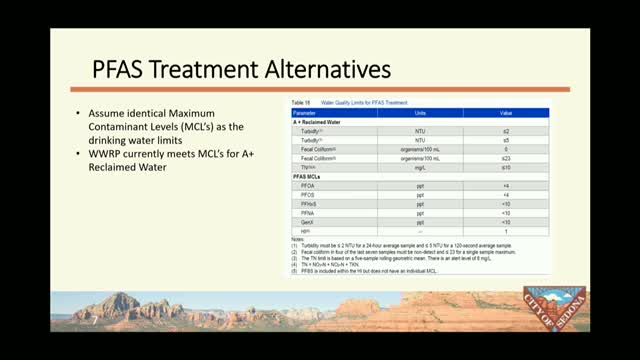Wastewater treatment facilities assess PFAS regulations and treatment options in upcoming plans
July 09, 2025 | Sedona, Yavapai County, Arizona
Thanks to Scribe from Workplace AI , all articles about Arizona are free for you to enjoy throughout 2025!

This article was created by AI using a video recording of the meeting. It summarizes the key points discussed, but for full details and context, please refer to the video of the full meeting. Link to Full Meeting
One of the key points raised was the absence of active regulations for PFAS removal in wastewater, with the city currently operating under the same maximum contaminant levels (MCLs) as those imposed for drinking water. The council noted that while Sedona's wastewater treatment facilities already meet certain water quality standards, they are still grappling with PFAS levels that exceed acceptable limits, particularly for PFOA, a specific type of PFAS.
The meeting revealed that the city has been proactive in testing both influent and effluent water, with results indicating that the effluent contains higher PFAS levels than the influent. This situation, while perplexing, is not uncommon in wastewater treatment processes due to various factors, including the materials used in treatment equipment.
Council members discussed the need for further research to identify the sources of PFAS within the treatment process. Suggestions included investigating the coatings used in equipment that may contribute to PFAS contamination. The conversation underscored the complexity of addressing PFAS, as these substances are often integral to the materials used in wastewater treatment due to their resistance to corrosion.
Looking ahead, the council is considering two treatment alternatives for PFAS removal: granulated activated carbon (GAC) and ion exchange. Both methods have been established as effective for PFAS treatment, but they come with different operational requirements and implications for future expansion. GAC, for instance, requires more frequent media changes but offers greater flexibility for adapting to new regulations, while ion exchange has a smaller footprint but involves more stringent disposal requirements for spent media.
The city has already included budget provisions for ongoing PFAS sampling and testing in its ten-year capital improvement plan, recognizing the importance of staying ahead of regulatory changes and ensuring the safety of local water sources.
As Sedona navigates these challenges, the discussions from the meeting reflect a commitment to addressing environmental concerns while safeguarding public health. The council's proactive stance on PFAS management is a crucial step in ensuring the community's water quality and environmental integrity in the years to come.
Converted from Sedona - City Council - Jul 09, 2025 meeting on July 09, 2025
Link to Full Meeting
Comments
View full meeting
This article is based on a recent meeting—watch the full video and explore the complete transcript for deeper insights into the discussion.
View full meeting
